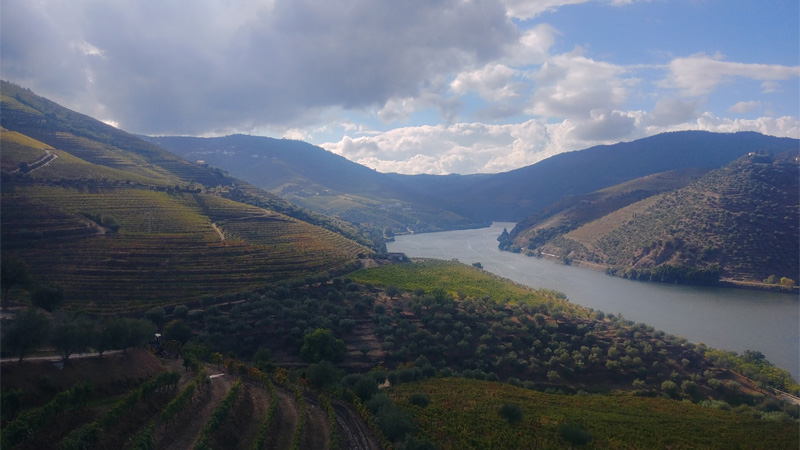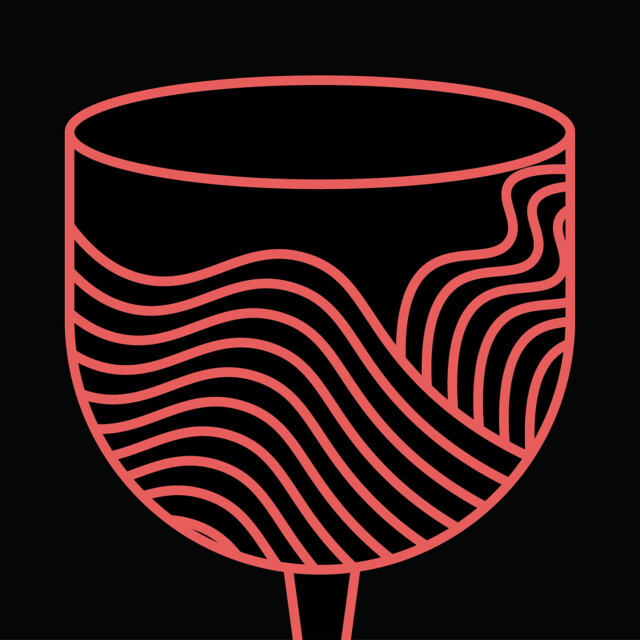Major changes are disrupting the established hierarchy in the world’s largest area of mountain vineyards.
Portugal’s Douro Valley — with its endless terraces carved out over millennia — has long been famous for the iconic and inimitable sweet Port wine it produces. And yes, the regal beverage sourced from this UNESCO World Heritage wine region continues to dominate dessert wine selections internationally and lord over the fortified wines of the world.
But a modernist usurper lurks within the ranks of the valley’s steeply terraced slopes. Growing ever stronger in Port’s shadow, dry Douro DOC table wine is finally ready to make its claim and challenge for Douro’s crown.
The Wine That Changed Douro
While the ongoing defenestration of a legendary institution like Port may feel like a recent cultural regicide, a changing of the guard had already begun decades ago. It was 1952 in Portugal’s “golden valley,” and peculiar things were afoot at Quinta do Vale Meão. The cleverly MacGyvered birth of Barca Velha was underway: Portugal’s first modern dry “cult wine” fashioned with Bordeaux-inspired winemaking techniques.
The aftershocks of this original upheaval have continued to slowly rumble through the valley as the winegrowing landscape fully settles into a new state of affairs. For centuries, Douro has always meant Port. However, this traditional association is now taking a back seat to the events set in motion by that 1952 epiphany. After all, dry table wines offer far more market exposure, require less tied-up capital, and are eternally en vogue and infinitely more versatile. It’s a practical reality impossible to ignore.
“Douro is Douro! It doesn’t have to look like any other region in the world.”
There’s a deep historical precedent for dry wine production in Douro, too, as Port was likely a serendipitous invention-turned-necessity for wine merchants shipping their product from Porto up to England beginning in the late 17th century.
Sure, that’s a long time, but it pales in comparison to Douro’s 2,000 years of organized viticulture. Additionally, though the Port style and methodology have been around for over 300 years, it was only in the 19th century that the practice of fortification with brandy — and resulting sweeter profile — was widely adopted.
This all points toward an awkward little secret for king Port: For about 90 percent of Douro’s winemaking history, dry unfortified wines ruled the land.
Dry Douro Wines Have Officially Arrived… Again
Douro Valley is back in the spotlight with a new old trick, and major critics are lavishing big scores and high praise on these gutsy, structured dry reds. While it’s tempting to conveniently compare these major league bottlings to other powerhouse regions like Napa and Bordeaux, the truth is that these vineyards and wines are undeniably unique.
“Douro is Douro!” says Miguel Roquette, proprietor and export manager at Douro’s acclaimed Quinta do Crasto. “It doesn’t have to look like any other region in the world.”
“In 2022 we saw a decline of around 1.5 percent in the sales of Port wine. We have seen many companies in the Port sector increase their investments in [dry table] wine, and this is due to the loss of around 30 percent in [Port] sales volume over the last 20 years.”
The diversity of site and singular Portuguese heirloom varieties in Douro provide a secret sauce that sets it apart from the usual global winegrowing convention. “A small plot may have different sun exposures, different altitudes, and different soils,” Roquette says. “In our opinion, the Douro region is the ultimate expression of terroir and microclimate.”
And while heavy-hitting warmer climate regions worldwide often rely on the usual cast of French characters like Cabernet Sauvignon, Merlot, and Syrah, the ancient Douro terraces contain a treasure that is virtually nonexistent elsewhere. “[There are] around 100 indigenous grape varieties; blends from 100-year-old vines,” says José Sá, wine school director at WOW Porto, the new wine culture district in Vila Nova de Gaia. “This gives our [dry] Douro reds an unparalleled complexity.”
This combination of power, diversity, and uniqueness has rewarded dry Douro DOC producers with a rapidly surging consumer following among those who seek out fuller-bodied, age-worthy bottlings. Legions of wine drinkers looking for that steakhouse red are discovering that Douro delivers on all fronts. If they can capture that Napa-esque experience with an appealingly distinctive character — all at half the price or less — then why not?

Sá confirms that the trend has been picking up steam over the past decade, with 2022 alone showing an increase in sales volume of 8.5 percent. However, this growing success has come at the expense of Port — or perhaps as a reaction to the vacuum decreasing Port sales have exposed. “In 2022 we saw a decline of around 1.5 percent in the sales of Port wine,” he says. “We have seen many companies in the Port sector increase their investments in [dry table] wine, and this is due to the loss of around 30 percent in [Port] sales volume over the last 20 years.”
The Big, Ugly Problem Holding Douro Back
With such an enthusiastic swell of interest happily filling the void left behind by ebbing Port sales volume, it seems at first glance that the sky’s the limit. There’s a catch, though. A critically looming financial thunderhead lies between Douro and its entry into the rarified air of top-flight big-red regions. An ugly grape-price inversion crisis is currently dampening the mood — and threatening the socioeconomic stability — of the valley.
On July 12, a collection of 26 Douro producers released a joint statement officially laying out the crisis and calling for action. The “Douro Deserves Better” open letter has exposed the severity of the issue while also providing hope that this malignant regulatory imbalance will finally be given the full attention it requires to find a cure. “Douro can only compete based on quality and not on price,” Roquette says. “Production costs in the Douro are substantially higher than in other regions, which puts pressure on all winegrowers.”
Surely, this moment of existential panic can be used as motivation. There’s agreement from Sá and others that it’s a crucial time for regulatory revision as the valley prepares for a new era of the industry — an opportunity to finally update the antiquated policy framework ruling the region to match Douro’s modern dry-wine reality. “We need to protect the 90 percent of winegrowers of Douro,” Sá emphasizes, ”[those] that have less than [2.5 acres] of vineyard, but represent the best of this region.”
If the crisis can successfully be navigated, then Douro table wine has the clearance to continue its meteoric rise and transformative renaissance.
Dry Douro Whites Make Their Case
The common refrain for dry, unfortified Douro wines usually makes reference to the valley’s red offerings. Rightly so. There’s no denying that these expressive, layered bottlings lead the charge for the region’s table wines.
But for travelers who have visited Douro — or anywhere in Portugal for that matter — it quickly becomes clear that the white wines sourced from these storied terraces are also distinctively appealing. A relaxing respite at one of the country’s thousands of park quiosques for an inexpensive glass of ubiquitous Planalto white immediately clues in most tourists to the open secret in-country.
“The potential is undoubtedly enormous, and the future is very promising.”
“We believe that right now we are still far below the full potential of the region for the production of white wines,” Roquette says. “When we plant the right indigenous white grape varieties at the right locations — 500 meters or higher with a transition of schist soils to granite — the result achieved is truly exceptional.”
Most producers in the valley agree that the white wines are an essential part of Douro’s evolution on the world stage. And though the recognition of these whites is lagging behind that of the reds, there’s no doubt that they’re a critical component for the future.
Port Still Culturally Irreplaceable
Dry Douro DOC table bottlings are continuing to shape and guide the modern fate of the valley, and it appears inevitable that this segment will soon drive the international consumption of Douro wines. “The potential is undoubtedly enormous, and the future is very promising,” Roquette says. And though Douro is still tweaking its message regarding these wines, their rapid growth is self-evident.
So, where does this dry, unfortified evolution leave that venerable soul, Port?
“We mustn’t forget our nectar of the gods,” Sá says. As long as there is Douro, there will be Port. Maybe in smaller quantities, but the valley’s denizens are determined to keep their distinguished fortified traditions alive and in the spotlight regardless.
“Port will always have its place assured as one of the greatest wines in the world,” Roquette says. “We were, we are, and we will always be Port producers.”
This story is a part of VP Pro, our free platform and newsletter for drinks industry professionals, covering wine, beer, liquor, and beyond. Sign up for VP Pro now!
